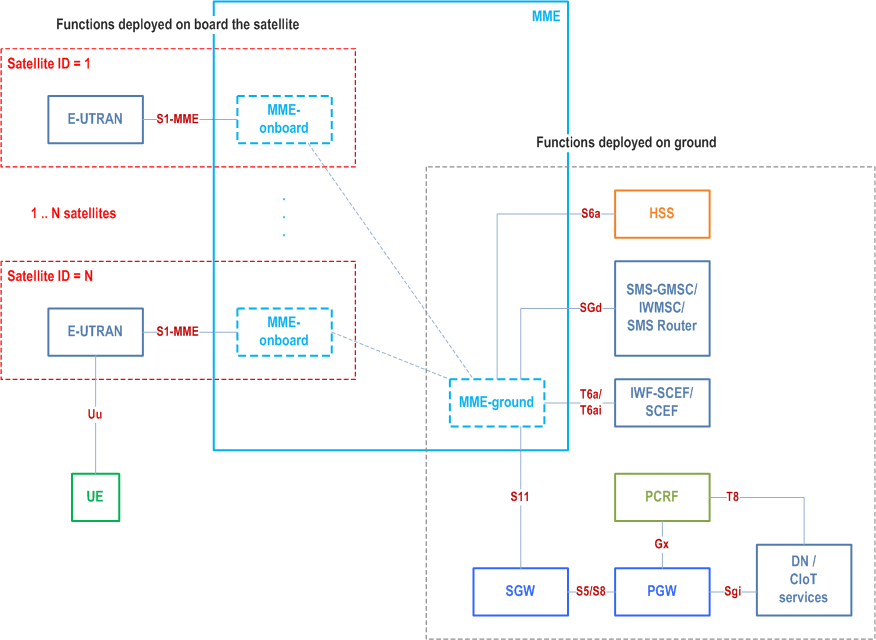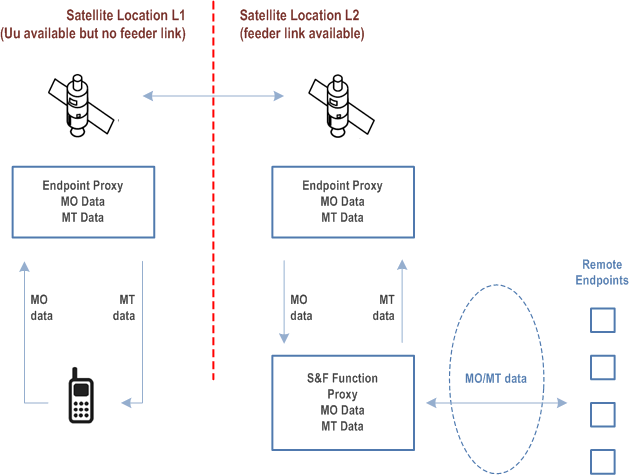Content for TS 23.401 Word version: 19.1.0
1…
4…
4.2.2…
4.3…
4.3.6…
4.3.8…
4.3.12…
4.3.16…
4.3.20…
4.3.25…
4.4…
4.6…
4.7…
4.13…
5…
5.1.2…
5.3…
5.3.2…
5.3.3…
5.3.3.2
5.3.3.3…
5.3.4…
5.3.4B…
5.3.5…
5.3.8…
5.3.9…
5.4…
5.4.4…
5.5…
5.5.1.2…
5.5.2…
5.5.2.2…
5.5.2.3…
5.5.2.4…
5.6…
5.7.3…
5.7A…
5.10
5.11…
5.19…
D…
D.3…
D.3.4
D.3.5
D.3.6
D.3.7…
D.3.8…
E
F…
J…
K…
L…
M…
O…
O Example Models of Store and Forward Satellite operation
O.1 Introduction
O.2 Model A: Split MME architecture
O.3 Model B: Full EPC in each satellite
O.3.1 General
O.3.2 Architecture and Principles of Operation
O.3.3 Support of MO and MT Transactions
$ Change history
O Example Models of Store and Forward Satellite operation |R19| p. 457
O.1 Introduction p. 457
This Annex provides guidance on deployment options to support store and forward satellite operation.
O.2 Model A: Split MME architecture p. 457
In this architecture option (see Figure O.2-1):
- eNB is onboard the satellite.
-
MME is split into two functions:
- MME-onboard: the MME part which is onboard the satellite. MME-onboard is in charge of (1) handling the S1 interface with the onboard eNB and (2) handling the NAS protocol signalling from/to UEs via the onboard eNB.
- MME-ground: the MME part which is on the ground network. MME-ground is in charge of handling the rest of interfaces towards other CN functions (e.g. S6a towards HSS, SGd towards SMS-GMSC/IWMSC /SMS Router, T6a towards SCEF, T6ai towards IWF-SCEF, S11 towards SGW).

The split-MME architecture has below principles:
- An MME-ground is associated with at least one MME-onboard. An MME-onboard is associated with a Satellite ID identifier. The MME-ground together with the associated MME-onboard(s) behave jointly as a single MME entity.
- How MME-onboard(s) interacts with MME-ground and how synchronization of the UE context between them is done is outside the scope of 3GPP.
- When a UE initiates a MO procedure that needs an interaction with a core network node on the ground, the MME-onboard stores the MO procedure transaction if the feeder link is not available and synchronizes with the MME-ground when the feeder link becomes available. The MME-ground executes the procedure with the ground network nodes and syncs back the UE context with the MME-onboard when the feeder link becomes available.
- The MO data is stored in the MME-onboard when the service link is available and the feeder link is unavailable, and transferred to the MME-ground when the feeder link becomes available. The MT data is stored in the MME-ground when the feeder link is unavailable and transferred to the MME-onboard when the feeder link becomes available. The MME-ground determines the satellite through which to send MT data and the MT data is sent to the respective MME-onboard and stored in the MME-onboard when the feeder link is available, and transferred to the UE when service link becomes available.
- For MO SMS, if the feeder link is not available upon reception of the MO SMS the MME-onboard can store the MO-SMS and can immediately send the delivery report (i.e. RP-ACK) to the UE i.e. as if the MO-SMS has already been successfully delivered to the Service Centre (SC). Once the feeder link is established the MO-SMS is forwarded to the SC. Subsequently the SC sends the RP-ACK to the UE. The MME-ground can also discard the RP-ACK received from the SC.
- To support UE location verification on satellite, the E-SMLC, if needed, can be deployed on satellite to perform the verification of UE location functionality.
- For the monitoring event which allows the SCS/AS to be notified of Store and Forward Satellite operation (see clauses 5.6.1.11 and 5.6.3.10 of TS 23.682) the SCS/AS communicates with HSS and MME-ground to configure and/or delete Monitoring Event.
- For data transfer, only Control Plane CIoT EPS Optimization applies.
O.3 Model B: Full EPC in each satellite p. 458
O.3.1 General p. 458
This clause describes an example of Model B for support of Store and Forward Satellite operation as defined in clause 4.13.9.
O.3.2 Architecture and Principles of Operation p. 458
An example architecture of Model B is shown in Figure O.3.2-1. Each satellite contains the functionally of an eNB plus a full EPC that can include an MME, SGW, PGW, HSS, E-SMLC, SMSC etc. Each satellite further includes an endpoint proxy function that emulates the behaviour of a real endpoint (e.g. an AF) from the perspective of a UE. There is also store and forward functionality on the ground that can be part of, or connected to, an NTN Gateway and that contains the proxy functionality.

O.3.3 Support of MO and MT Transactions p. 460
An MO or MT transaction for Model B can correspond to:
- Transfer of an SMS message.
- Transfer of data to or from a remote endpoint using Control Plane CIoT EPS optimisation or User Plane.